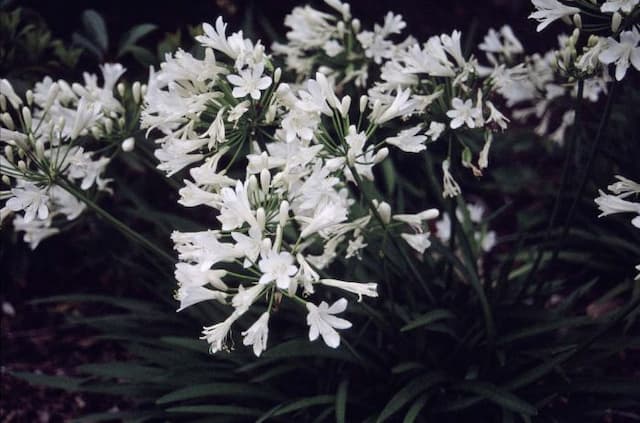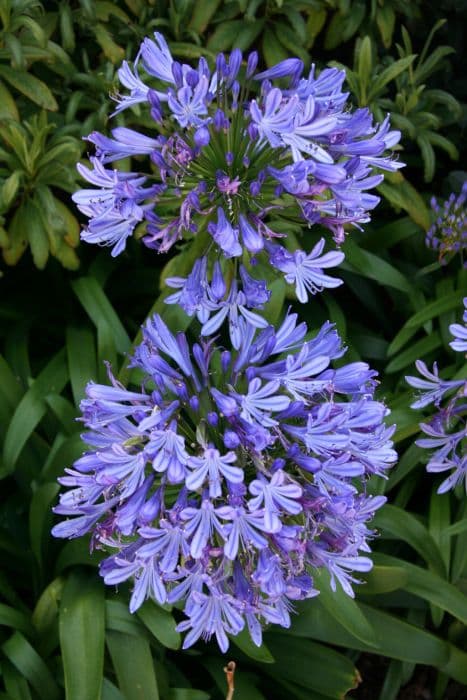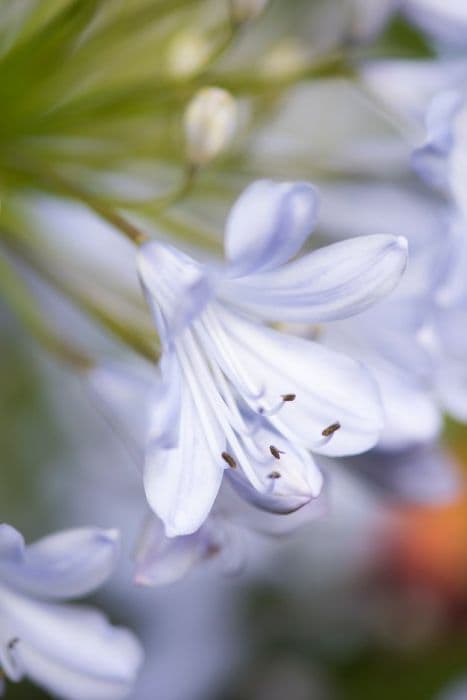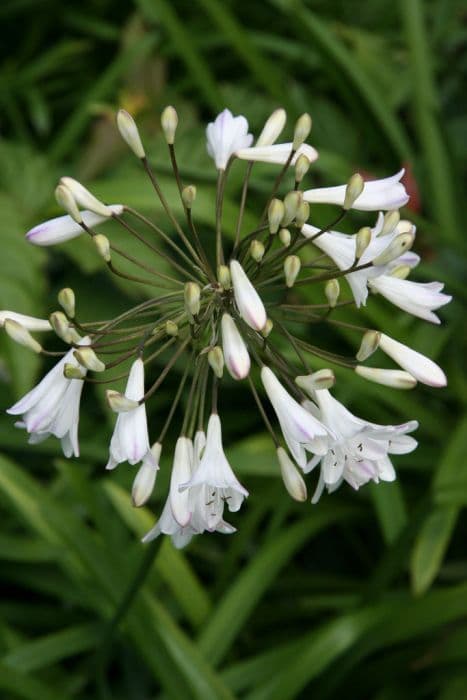African Lily Agapanthus 'Maureen'

ABOUT
Agapanthus 'Maureen' is a striking ornamental plant recognized for its lush, strap-like dark green leaves that gracefully arch outward, forming a dense foliage clump. The standout feature of this plant is its spectacular bloom. During the flowering season, long, sturdy stems rise above the tuft of leaves, topped with large, rounded clusters of funnel-shaped flowers. The flowers are typically a beautiful shade of blue or purple, offering a vivid contrast against the greenery below. Each of these clusters is made up of numerous individual flowers that come together to form a magnificent sphere of color that can resemble fireworks exploding in the sky. The blooms are not only a visual delight but, depending on the variety, can also attract pollinators like bees and butterflies, which adds to the dynamism of the display. The overall appearance of Agapanthus 'Maureen' is one of dramatic elegance, making it a popular choice for garden borders, container gardens, and as an eye-catching focal point in any landscape design. Despite not discussing its dimensions, the plant's visual impact comes from its lush foliage and the showy bloom stalks that rise prominently above the leaves.
About this plant
 Names
NamesFamily
Amaryllidaceae
Synonyms
African Lily, Lily of the Nile, Love Flower
Common names
Agapanthus 'Maureen'
 Toxicity
ToxicityTo humans
Lily of the Nile and African Lily, a common name for Agapanthus 'Maureen', is mildly toxic to humans if ingested. It can cause gastrointestinal symptoms such as nausea, vomiting, and diarrhea. In some cases, ingesting this plant may also lead to dizziness or skin irritation. Care should be taken to avoid ingesting any part of the Lily of the Nile to prevent these possible consequences.
To pets
Lily of the Nile and African Lily, the common name for Agapanthus 'Maureen', is considered toxic to cats and dogs. If pets ingest parts of this plant, they may experience symptoms such as nausea, vomiting, abdominal pain, and diarrhea. Severe cases might lead to drooling, lethargy, or tremors. Owners should prevent their pets from chewing or ingesting any part of the Lily of the Nile, as it can have harmful effects on their health.
 Characteristics
CharacteristicsLife cycle
Perennials
Foliage type
Evergreen
Color of leaves
Green
Flower color
Blue
Height
4 feet (1.22 meters)
Spread
2 feet (0.61 meters)
Plant type
Herb
Hardiness zones
8
Native area
South Africa
Benefits
 General Benefits
General Benefits- Ornamental Value: Agapanthus 'Maureen', commonly known as African Lily, provides a striking visual impact in gardens with its tall flower stalks and beautiful blue to purple blooms.
- Drought Tolerance: African Lily exhibits a good level of drought tolerance once established, making it suitable for water-efficient landscaping.
- Low Maintenance: It generally requires minimal care beyond the initial planting and occasional watering, making it a great plant for both novice and busy gardeners.
- Wildlife Attraction: The flowers of the African Lily attract bees, butterflies, and other pollinating insects, which are beneficial for the garden ecosystem.
- Long Blooming Season: It has a long flowering period, providing color and interest in the garden throughout summer into early fall.
- Versatility: The African Lily is versatile and can be used in a variety of garden settings such as borders, containers, and as a focal point.
- Perennial Growth: As a perennial plant, it will return year after year, making it a cost-effective choice for long-term landscaping.
- Soil Adaptability: It can adapt to a range of soil types, though it prefers well-drained soil, making it a good choice for different garden conditions.
- Clumping Growth Habit: The clumping nature of African Lily helps to suppress weeds and reduce garden maintenance.
- Propagation Ease: It can be propagated relatively easily by division, allowing gardeners to multiply their plants and share with others.
 Medical Properties
Medical PropertiesThis plant is not used for medical purposes.
 Air-purifying Qualities
Air-purifying QualitiesThis plant is not specifically known for air purifying qualities.
 Other Uses
Other Uses- Landscape Design Accent: The Agapanthus 'Maureen' can serve as a striking focal point in landscape designs, especially when planted in groups for a dramatic display of its large, blue flower clusters.
- Pond Borders: This plant can be used around the borders of a pond or water feature, offering a soft transition between the water's edge and the garden.
- Erosion Control: Their dense root systems can help stabilize soil on slopes, making them an ideal choice for erosion-prone areas.
- Privacy Screening: When grown en masse, Agapanthus can form a dense barrier, providing a degree of privacy and wind protection.
- Seaside Gardens: Agapanthus is salt-tolerant and can thrive in coastal gardens, where other plants may struggle due to harsh seaside conditions.
- Culinary Decoration: Although not commonly known for culinary uses, the flowers can be used as a decorative garnish for salads and deserts, provided they haven't been treated with pesticides.
- Fabric Dyeing: The deep blue of the Agapanthus 'Maureen' flowers can potentially be used to create natural dyes for fabrics.
- Companion Planting: Agapanthus can be planted among vegetables and fruits to create a visually appealing kitchen garden, with the added benefit of potentially attracting pollinators.
- Photography: The striking appearance of the Agapanthus lends itself to being an excellent subject for botanical photography, aiding in gardening blogs and promotional material.
- Artistic Inspiration: The unique form and color of the Agapanthus can be used as inspiration for artists looking for natural beauty to translate onto canvas.
Interesting Facts
 Feng Shui
Feng ShuiThe Agapanthus, commonly known as Lily of the Nile, is not typically associated with Feng Shui practice.
 Zodiac Sign Compitability
Zodiac Sign CompitabilityThe Lily of the Nile is not used in astrology practice.
 Plant Symbolism
Plant Symbolism- Love Letters: The name Agapanthus is derived from the Greek words 'agape' meaning love, and 'anthos' meaning flower, symbolizing a love letter or a message from a loved one.
- Beauty: Agapanthus, commonly known as the Lily of the Nile, is admired for its stunning blue funnel-shaped flowers, which represent beauty and elegance.
- Fertility: Due to its lush foliage and ample blossoms, the Lily of the Nile is also associated with fertility and abundance.
- Endurance: Agapanthus plants are known for their hardiness and ability to thrive in various conditions, symbolizing endurance and resilience.
 Water
WaterLily of the Nile prefers even moisture, so water when the top inch of soil feels dry to the touch. During the active growing season in spring and summer, this may mean watering once or twice a week, supplying, on average, about one to two gallons of water per week, depending on climate and soil drainage. Decrease watering in fall and winter, providing only enough to prevent the soil from becoming completely dry. Ensure good drainage to prevent root rot, and consider reducing the quantity if rainfall is sufficient to keep the soil moist.
 Light
LightLily of the Nile thrives best in full sun to partial shade. Ideally, select a location that receives at least six hours of direct sunlight each day. If you live in a region with very hot summers, providing afternoon shade will help protect the plant from intense heat, ensuring the vibrant bloom and health of the plant.
 Temperature
TemperatureLily of the Nile can handle a range of temperatures but thrives in conditions between 60 to 80 degrees Fahrenheit. The plant is hardy and can survive brief dips down to about 50 degrees Fahrenheit, but it's not frost-tolerant. In regions where temperatures consistently fall below this range, protection or indoor overwintering is necessary.
 Pruning
PruningPruning Lily of the Nile is generally done to remove spent flower stalks and to tidy up any dead or damaged foliage. Cut spent stalks back to the base after blooming to encourage additional blooms and maintain plant appearance. The best time to prune for plant health and shape is in the late winter or early spring before new growth begins.
 Cleaning
CleaningAs needed
 Soil
SoilAfrican Lily 'Maureen' thrives in well-draining soil mix, comprising equal parts loam, sand, and peat with a pH between 6.0 and 8.0, slightly acidic to alkaline.
 Repotting
RepottingAfrican Lily 'Maureen' should be repotted every 2-3 years or when it becomes root-bound in its pot.
 Humidity & Misting
Humidity & MistingAfrican Lily 'Maureen' fares well in average room humidity, without the need for any special humidity requirements.
 Suitable locations
Suitable locationsIndoor
Place African Lily 'Maureen' in bright, indirect light inside.
Outdoor
Plant African Lily 'Maureen' in full sun to part shade.
Hardiness zone
8-11 USDA
 Life cycle
Life cycleThe African Lily 'Maureen' begins its life as a seed, which, once germinated in favorable growing conditions, develops into a small seedling. This seedling gradually grows, developing a rhizomatous root system and strap-like leaves, becoming a vegetative plant. Over time, usually after a couple of years, the plant reaches maturity and produces tall, round flower stalks topped with spherical clusters of blue or violet flowers during the summer months. After the blooming period, the flowers develop into capsule-like fruits that contain seeds, which can be dispersed to start a new generation. Throughout the growing season, the plant can be propagated by dividing mature clumps, allowing for vegetative reproduction as well. When the plant enters dormancy, usually in response to cold temperatures or seasonal changes, the above-ground foliage may die back, with the plant relying on its underground structures to survive until the next growing season.
 Propogation
PropogationPropogation time
Spring-Early Summer
Agapanthus 'Maureen', commonly known as Lily of the Nile, is best propagated by division, a process typically conducted in the spring or early fall when the plant is not in active bloom. Division involves gently separating the thick, fleshy roots known as rhizomes to create new plants. During division, it is important to ensure that each section includes at least one fan of leaves and a portion of the root system. These divisions are then replanted into well-draining soil, given ample water to establish, and should be spaced approximately 18 to 24 inches (45 to 60 centimeters) apart to allow for growth. Dividing every three to four years helps to prevent overcrowding and maintains plant vigor.




![African lily [Blue Storm]](/_next/image?url=https%3A%2F%2Fplants-admin.emdemapps.com%2Fimages%2Fplants%2F%2Fimages%2F604b63200a08b.png&w=640&q=75)




